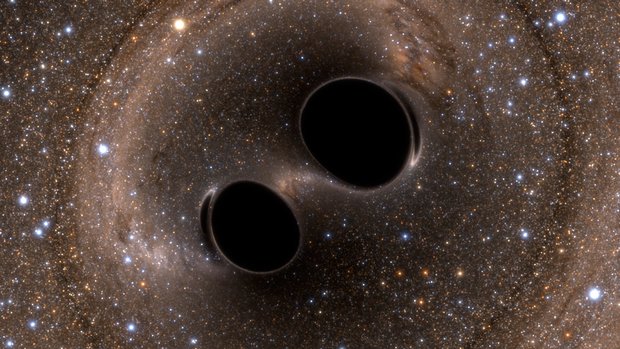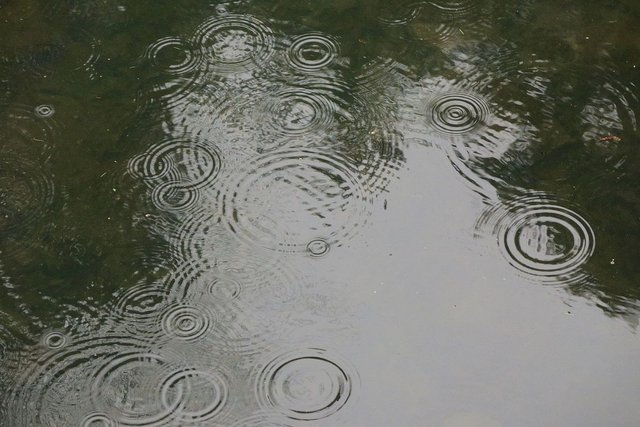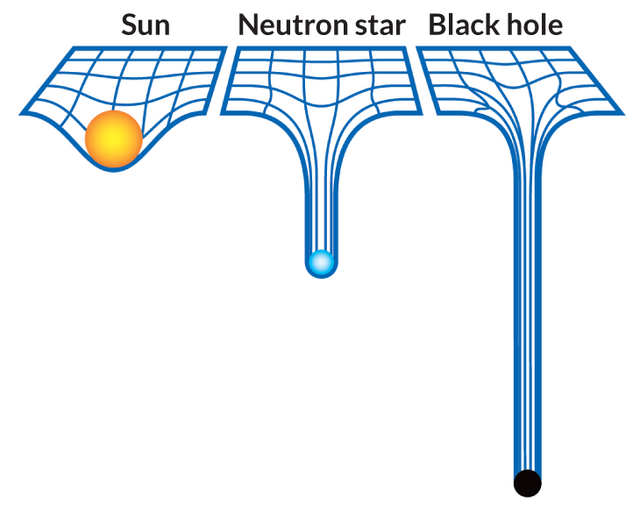General relativity 101 - Gravitational waves in a nutshell
As the entire Steem planet probably knows it today, SteemSTEM and Utopian.io are currently organizing their future joint meetup at Virgo Labs, close to Florence and Pisa in Italy. For more information, please do not hesitate to visit our @fundition campaign aiming to cover the costs of this enormous event (see here).

[image credits: The SXS Project (CC BY-SA 4.0)]
During the meetup, both communities will pay a visit to Virgo Labs, one of the three places in the world currently hunting for gravitational waves.
But what are those waves that everybody (at least in the particle physics, cosmology and astrophysics communities) speaks about? And how can we detect them in practice?
To answer those questions and in order to allow the meetup participants to be well prepared to what they will see, I will start releasing some relevant material. Through a short series of posts, I will hence explain with all glory details the basics underlying the physics that we are after, and the Virgo experiment that we will visit.
With this post, I start by defining gravitational waves and how they can be formed.
WAVES
Before even discussing what a gravitational wave is, let us first focus on what a wave is in full generality.
We begin with considering a local disturbance of a system from a state of equilibrium, i.e. when all potential effects on the system compensate each other so that nothing moves, heat is not transferred, etc.
One says that we are in the presence of a wave when the disturbance propagates from its source in all directions, with time passing, without implying any global motion of the constituents of the system.

[image credits: Patrick Nordmann (CC BY-SA 4.0)]
A wave does therefore not transport matter but solely energy (as the constituents of the system are still).
Instead of getting further into a complex definition, let us take instead the image on the right where waves are created on a water surface by raindrops.
If we take a fixed point in space, we may well lie, at a given moment, at the trough between two crests. However, the wave propagates from its source so that at a later moment, the same point may well be connected to a crest. A bi further in time, we could again lie at a trough, and so on. We have thus a time periodicity: a given point in space will see a sequence of crests and troughs with time passing.
Similarly, we can consider a straight line ranging from the center of the wave (the location at which an airdrop fell) in any given direction. Along the line and at a given moment, we will observe a sequence of peaks and troughs, with a space periodicity.
A wave is thus a phenomenon featuring both a spatial and time periodicity. The propagation of the wave in space could occur through matter (for instance in the case of sound waves or any mechanical wave) or through the vacuum (like for instance for electromagnetic or gravitational waves).
A FLAT SPACETIME BENT BY MASSES
In order to understand how gravitational waves are formed, it is good to first study general relativity a little bit, just to get information on the structure of space and time. We will then go back to waves.

[image credits: Ksshd (CC BY-SA 4.0)]
Let us start by imagining that our universe is made of a flat sheet of paper, and that any object lying in it (a star, a galaxy, a planet, etc.) consists in a marble of a given mass and density.
Different marbles connected to different classes of astrophysics objects (again stars, galaxies, planets, etc.) will then deform our sheet of paper, as illustrated on the picture on the left.
The picture also shows that heavier and more compact objects deform space more than lighter and less dense objects.
Because of these deformations, any motion is affected by this bending. In general relativity, the bending of space therefore implies the orbital motion of stars, planets and galaxies. The orbit of a planet is hence analogous to the motion of a marble on a curved surface: even if sent straight close to a massive object, the marble ends up orbiting in circles around the more massive object.
GRAVITATIONAL WAVES

[image credits: Charly W. Karl (CC BY-ND 2.0)]
To understand how gravitational waves are produced, we need to consider two massive objects orbiting around each other (although strictly speaking, this is not the only way to generate gravitational waves).
The two masses accelerate, and this acceleration causes changes in the distortion of space. This local disturbance is the phenomenon that generates gravitational waves. This is actually very similar to the electromagnetic waves generated by an accelerated electric charge.
Whilst any single pair of orbiting objects generates gravitational waves, the magnitude of the waves depends on the masses involved. Gravity is the weakest of all forces, and this weakness must be compensated by large masses.
To notice anything, one therefore needs a lot of mass localized in a small region of space. In short, one needs very massive and compact objects like black holes or neutron stars.
And even with those monsters rotating around each other, one ends up with the challenge of observing deviations of space of 0.0000000000000000001 meter. This is what LIGO and Virgo have achieved and why gravitational waves were the topic of the Nobel prize in physics in 2017. But this will be the topic of the next post of this series.
SUMMARY AND TAKE-HOME MESSAGE
With the up-coming SteemSTEM and Utopian.io meetup at Virgo Labs, I have started writing some documentation about the physics that is done in this laboratory.
In this post, I have tried to detail what is a gravitational wave and how it is produced, starting with the definition of a wave (a propagating phenomenon in space). I have then moved on with some general relativity, emphasizing how gravity is connected to the structure of our flat universe and I have finally detailed how accelerated masses generate gravitational waves.
However, accelerating monsters like black holes or neutron stars generate waves having an amplitude of 0.0000000000000000001 meter. In the next episode, I will explain how LIGO and Virgo have managed to observe such a tiny disturbance of space.
Please do not hesitate to ask questions!
STEEMSTEM
SteemSTEM is a community-driven project that now runs on Steem for almost 2 years. We seek to build a community of science lovers and to make Steem a better place for Science Technology Engineering and Mathematics (STEM). In particular, we are now actively working in developing a science communication platform on Steem.
More information can be found on the @steemstem blog, in our discord server and in our last project report.
I think I have a question? How do these measurements and findings affect the way we perceive the universe from a physical-scientific perspective? What do know that we did not know before we could measure these, aside from their existence?
So you think you have a question but you are not sure... hmmm...
Gravitational waves were a predictions of general relativity, but they were never observed so far. This someone was the missing observation to validate this theory. Moreover, we today now that gravity propagates at the speed of light. Again, this matches the predictions, but we needed the confirmation. Finally, this is also the first direct observations of black holes. However, we are still trying to confirm that general relativity the correct theory of gravity?
We have also technically managed to observe something as tiny as 0.000000000000000001 meter. This is a great accomplishment as such.
Now the next steps consist in using more data to get a better knowledge on the first moment of the universe (things we cannot do with light, for instance). This could be (or could not be) connected with dark matter, and so on. For instance, dark matter could be made of primordial black holes. There are still plenty of things we don't know and we need more information about.
i never had much trouble with the visualisation of einsteins concept of spacetime , my abnormal non-verbal mind probably helps a bit with that. It's basically where i get most of my metaverse-philosophy from. I see entities and gravity everywhere ... two people in a couple revolving, megacorporations with satellite business, suns and planets, planets and moons, gravity on every level and everything's an entity , grouped or not.
I never thought about the waves like this though but it makes total sense, if a massive object causes a dent in the fabric of space(time) then motion creates ripples, but what does it consist of ?
is this what you call "gravitons"? and so gravitons are massless particles, pure energy, like fotons ? only fotons DO have mass when moving, right ? since that's why you can't go faster than light according to accepted theory, mass becomes infinite (thats why i keep saying all you need for FTL is infinite amounts of energy - on an abstract mathematical level lol)
i see the waves though if i think about, two whales dancing around each other in the big steem-sea , attracting all those dolphin due to their massive size, in turns attracting all those minnows due to the combined mass of this mini galaxy
and all the plankton round it :p
visualization, gotta love it
Well, gravity is there indeed.
Accelerating masses create ripples in fact. Not any motion.
Gravitons have not been observed yet. In fact, there is probably no way (at least today) to observe them by virtue of their tiny interaction strengths (assuming they exist). And what you said is correct: of gravitons exist, they are massless.
interesting thoughts :)
i have lots of thoughts, sometimes a bit too many, some more interesting than others, i got one answer completely right ... 1outof4 i didnt pass the exam yet :|
so that's ripples in space-time , or an actual oscillation in energy through space ?
Gravitational waves carry energy. So both would work, somehow.
Gravitational
Waves carry energy. So
Both would work, somehow.
- lemouth
I'm a bot. I detect haiku.
both should work somehow ... schroedingers cat all over , that's quantum physics for ya ... life used to be simple, 1+1=2 , now 1+1 might be 2 in most cases hahah, i dont understand how any single person can cram all that into one brain, really. I consider myself slightly above average on a classic 1960s intelligence scale as defined by people who need to measure it but a lot of this is material i really need to read two or three times. It gets a lot better when you leave the numbers and the symbols out, that's why i like your work so much
, that's quantum physics for ya ... life used to be simple, 1+1=2 , now 1+1 might be 2 in most cases hahah, i dont understand how any single person can cram all that into one brain, really. I consider myself slightly above average on a classic 1960s intelligence scale as defined by people who need to measure it but a lot of this is material i really need to read two or three times. It gets a lot better when you leave the numbers and the symbols out, that's why i like your work so much 
oh, looks like you got a haiku there, quantum-poetry ... maybe time for a part-time career on stage ? :)
Quantum poetry requires quantum emoticons (just read it this morning) ^^
quantum computing avant la lettre ? That is mighty interesting ... allow me to push it on the stack right after "introduction to python" ... seems its going to be hard to do automated posts without any bit of python so i guess i'll have to ... thanks a lot for the link , that looks REALLY interesting
experiments in quantum computing ...
I had a lot of fun to read this post. However, note this is very far from my zone of comfort ;)
Nicely written. Tho I got an improvement for your picture that demonstrates how much different things weigh... ;)
That is a verrrrryyyyy heavy SBD... very compact too :D
Wow, cool post and the meetup looks like it is going to be awesome too!
How do gravity waves operate at the quantum level? Wave is a particle, particle is a wave, thus gravity is a particle?
Newtonian physics starts to get weird at quantum levels so wondering what your thoughts are on how gravity works then?
Cheers and cool post.
Interesting to consider...
I wish we knew it. This is a full field of research today, and physicists are trying to understand how it is possible to quantize gravity.
My thoughts are the following: all the interactions are quantized. Therefore why no gravity? However, the way to understand how gravity could be quantized implies... a lot of work :)
To summarize, I am afraid that for now, I cannot answer your question.
Thanks for your thoughts on this!
Full agreement that if all interaction are quantized then gravity should as well. Wait and see or get out and develop the right experiments to test it...
Anyway, thanks for the frank response. My "gut feeling" is that understanding how gravity operates at quantum scales will provide insight into the theory of everything... cheers!
I agree with this. The question being: will we ever manage (in very few words, this demands to shake quite strongly quantum field theory to generalize it :p )
To answer your question: not sure...
Hopefully or likely AI can help!! Hahaha. Before it tries to take us out! Ever seen Black Mirror (the show)?
No one can be sure :)
I haven't seen the show (I even have no idea what it is about (will google it later)).
I am not too keen on TV or shows in general, but for some excellent science fiction and discussion about technology, AI, etc, Black Mirror is the way to go...
https://en.wikipedia.org/wiki/Black_Mirror
Black Mirror
Black Mirror is a British science fiction anthology television series created by Charlie Brooker, with Brooker and Annabel Jones serving as the programme showrunners. It examines modern society, particularly with regard to the unanticipated consequences of new technologies. Episodes are standalone, usually set in an alternative present or the near future, often with a dark and satirical tone, though some are more experimental and lighter.
The show premiered for two series on the British television channel Channel 4 on December 2011 and February 2013, respectively.
PS. Basically what are your thoughts on quantum gravity and the graviton? Thanks (or is this a future post?)!
I've been thinking that energy is grouped as matter. I guess I was wrong.
I've now understood why the sun is able to hold up other planets in the force of gravity - because of its size.
I've learnt a lot from this post. Thanks for sharing
I am not sure to understand the above sentence. Do you mind clarifying?
Not only the size. It is a matter of both its mass and its density. the sun bends the space around it, so that planets can only orbit around it following the curvature.
I've been thinking that "matter" is anything that has mass and occupies space (okay, that's what we were taught in the elementary school).
And I was also taught that energy is the property of matter.
That was why I assumed that matter and energy are somewhat related.
But when I saw these words "A wave does therefore not transport matter but solely energy". I then realized that "matter" and "energy" are two different concepts.
Being related does not mean they are the same thing. Mass energy is one type of energy. But energy can also be radiated for instance. In the case of waves, energy is transmitted in a way the system does not undergo any global motion.
Okay I now understand. Thanks for the tutorials sir
Adding clarifications is always a pleasure :)
you were taught about matter in elementary school ? lol ... size and mass are not the same like one kilo of lead and one kilo of feathers as the classic story goes , i wish i was taught about matter in elementary school :p
I taught my son when he was in grade 1. i.e. earlier this year :)
don't get me wrong here, i think its a GREAT idea, the younger kids are the easier they take things in and the earlier you gain knowledge the more connecting points you have which means you can absorb more faster without people having to explain. My only benefit was that i could read before 1st year so i got a bit of a headstart because i could take in a lot more of everything i saw around me.
Now if they had taught me about the movement of the planets (even just that) when i was six (or even in kindergarten, as long as it comes with metafors) i would probably be a bit further than having had to just nag my parents with questions until the buried me under encyclopedia lol
i wasnt like acting as if it would be too hard for a kid, i just say its a shame it doesnt get done ... i think a toddler can get the basic concepts if they come in tales, maybe ESPECIALLY them, and if they have their world image instated like that from very young age, then everything after that will be interpreted in a framework of understanding, it should be .. .exponential ?
it still shows btw, im nothing of a teamplayer and id rather drop dead looking things up for 24 hours or more before i ask anyone lol
first three years as they say , but maybe its the first six (well they would be freud and freud suffers a bit from local era-syndrome i'm afraid not all his stuff is applicable across all culture and times)
which is not physics ofcourse, although everything is physics since brains are made of particles
but you just said that to brag because its your kid didnt you :p
i know a thing or two about the competitive ego of the scientist ... i suppose it can be hard sometimes
its a quest for immortality, isnt it ?
What matter is not the topic but how the message is passed to the next generation (and which messages). :)
in most cases i would definitely agree, but some people have really bad messages haha , i see there's a new article, time to dust of my french, actually not bad you do that now and then, i can use some practice, i dont have money to visit paris once a month lol
Another interesting read @lemouth, I'm always very excited to read about gravitational waves.
I assume that enormous amounts of energy would be needed in order to produce gravity waves. Could we create some sort of wave generator or wave amplifier given the fact that gravitational waves do exist? Could we obtain all the energy needed with the use of antimatter and some sort of thermonuclear reactor?
But then again could we make use of those large amounts of energy efficiently or would it all be wasted in the form of heat?
Have a good day!
No, even two humans dancing around each other would produce gravitational waves. However, one needs a lot of energy to produce potentially observable gravitational waves.
To produce observable gravitational waves, we need much more energy than that (orbiting black holes or neutron stars). Nothing that humans can produce.
I was watching a video on the merging black hole event and I think they said that the power output at the moment of the merger was 50 times the power output of the observable universe (at least for that fraction of a second).
My question is:
If a life form was "close" to this event, say a million km away, would the spacetime distortion kill that creature? Or would the creature just distort along with the spacetime and never notice a thing?
Source:
https://www.sciencenews.org/article/black-hole-smashup-generated-yottawatts-power
The magnitude of the ripples are of about 10-19m. In this case, I don't think this will kill anything. The creature won't even notice such a distortion. By the way, gravitational waves are going through Earth all the time and we don't even detect them.
I love your raindrop analogy.
One question though. When Newton described gravity in his laws of motion, he was criticized as to not explaining why his laws work, only that they do work. Of course science at the time had no idea of curved space-time as an explanation.
But the criticism is only kicked down the road. Can you explain for me why mass bends space-time?
Joe
@joe.nobel
science fiction, fantasy, erotica
No, because we don't know. There is for the moment not any widely accepted theory answering this question. It is just that it works and that's it. Of course, we are not satisfactory and we are trying to understand things better. But this takes time. Hopefully, I will be able to answer your question one day. But no one knows... ;)
I find physics fascinating but I know there's a lot that is not known and may mever be known. I'm glad there's people who are willing to desicate themselves to this endeavor because I don't have the drive or will to do it myself wven knowing it could open up so many possibilities.
We are constantly learning and discovering more, pushing the limits further. This is all what science is actually about.
Very good article on gravity. This is one of my favorite topics in Physics. I enjoyed reading it though with a little help from the google-translator :-D. Thanks for sharing @lemouth. Regards.
I am indeed stuck with French and English. I could actually write in other languages too, bu one may end up with something not very pleasant to read. Therefore I will pass :D
I hope that I have not written something unpleasant because of my inexperience in English @lemouth :-D
Don't worry. This was fine :)